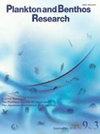A sea pen field in shallow water in the Amakusa Islands, southern Japan
IF 0.9
4区 生物学
Q4 MARINE & FRESHWATER BIOLOGY
引用次数: 3
Abstract
: Sea pens are ecologically important habitats for associated marine organisms, serving as ecosystem engi neers in sandy or muddy seafloor environments. In such areas, sea pens can form habitats with high population densi ties known as “ sea pen fields ” . However, the presence and importance of sea pen fields have not been well studied in shallow waters in East Asia. Here, we report a sea pen field of Virgularia sp. aff. gustaviana in the shallow waters of Ushibuka Marine Park, in the Amakusa Islands of southern Japan. The average colony numbers of the field across all depths (7–20 m) was 10.3 colonies/m 2 (live colonies) to 13.6 colonies/m 2 (all: live + dead colonies + holes), and the area of the sea pen field was at least ∼ 50,000 m 2 . At a depth of 15 m, the substratum consisted of sand and fallen leaves of terrestrial origin, and the highest sea pen density was observed (averages = 17.2 live colonies/m 2 , = 25.8 total (live + dead + holes) colonies/m 2 ). At a depth of 20 m, the substratum consisted of broken shells and rocks and had the lowest density (live colonies: average = 0.8 colonies/m 2 , all: average = 1.0 colonies/m 2 ). There were significant differ ences in colony number of Virgularia sp. aff. gustaviana between the “ sand ” , “ sand + leaves ” , and “ broken shells/rocks ” substrates. We hypothesize that the strength of the water currents caused by local geographic features and tidal move ments produce suitable sedimentation and habitat for this species of sea pen. Therefore, we suggest that preserving the natural coastline is crucial to protect this and other sea pen fields in shallow waters and their benthic marine communi ties.在日本南部的Amakusa群岛的浅水中的一个海围栏
:海堤是相关海洋生物的重要生态栖息地,在沙质或泥泞的海底环境中起着生态系统工程师的作用。在这些地区,海堤可以形成种群密度高的栖息地,被称为“海堤场”。然而,东亚浅水区海洋围栏的存在和重要性尚未得到很好的研究。在这里,我们报道了一个Virgularia sp.affe的海洋围栏。在日本南部的Amakusa群岛的Ushibuka海洋公园的浅水中的阵风。所有深度(7–20 m)的场平均菌落数为10.3个菌落/m 2(活菌落)至13.6个菌落/m2(全部:活菌落+死菌落+洞),海堤场面积至少为~50000 m 2。在15m深度处,下层由沙和陆生落叶组成,观察到最高的海堤密度(平均=17.2个活菌落/m2,=25.8个总(活+死+洞)菌落/m2)。在20 m深度处,基质由破碎的贝壳和岩石组成,密度最低(活菌落:平均=0.8个菌落/m 2,全部:平均=1.0个菌落/m2)。Virgularia sp.的菌落数量存在显著差异。“沙子”、“沙子+树叶”和“破碎的贝壳/岩石”基质之间的古斯塔维亚纳。我们假设,由当地地理特征和潮汐移动引起的水流强度为该海堤物种产生了合适的沉积和栖息地。因此,我们建议,保护自然海岸线对于保护该海域和其他浅水海域及其底栖海洋群落至关重要。
本文章由计算机程序翻译,如有差异,请以英文原文为准。
求助全文
约1分钟内获得全文
求助全文
来源期刊

Plankton & Benthos Research
Agricultural and Biological Sciences-Aquatic Science
CiteScore
1.30
自引率
0.00%
发文量
32
期刊介绍:
Plankton and Benthos Research is a peer-reviewed journal publishing quarterly original papers, reviews and notes dealing with any aspect of the biology and ecology of planktonic and benthic organisms and their interactions with the environment in any aquatic system, and is open to all scientists around the world. Submission of a paper is held to imply that it represents an original contribution not previously published and that it is not being considered elsewhere.
 求助内容:
求助内容: 应助结果提醒方式:
应助结果提醒方式:


